LMV822MX/NOPB National Semiconductor, LMV822MX/NOPB Datasheet - Page 11

LMV822MX/NOPB
Manufacturer Part Number
LMV822MX/NOPB
Description
IC OP AMP R-R LOW VOLT LP 8-SOIC
Manufacturer
National Semiconductor
Datasheet
1.LMV821M5NOPB.pdf
(24 pages)
Specifications of LMV822MX/NOPB
Amplifier Type
General Purpose
Number Of Circuits
2
Output Type
Rail-to-Rail
Slew Rate
2 V/µs
Gain Bandwidth Product
5.6MHz
Current - Input Bias
100nA
Voltage - Input Offset
3500µV
Current - Supply
500µA
Current - Output / Channel
45mA
Voltage - Supply, Single/dual (±)
2.5 V ~ 5.5 V, ±1.25 V ~ 2.75 V
Operating Temperature
-40°C ~ 85°C
Mounting Type
Surface Mount
Package / Case
8-SOIC (3.9mm Width)
Rail/rail I/o Type
Rail to Rail Output
Number Of Elements
2
Unity Gain Bandwidth Product
5.6MHz
Common Mode Rejection Ratio
72dB
Input Offset Voltage
3.5@5VmV
Input Bias Current
100nA
Single Supply Voltage (typ)
2.7/5V
Dual Supply Voltage (typ)
Not RequiredV
Voltage Gain In Db
105dB
Power Supply Rejection Ratio
75dB
Power Supply Requirement
Single
Shut Down Feature
No
Single Supply Voltage (min)
2.5V
Single Supply Voltage (max)
5.5V
Dual Supply Voltage (min)
Not RequiredV
Dual Supply Voltage (max)
Not RequiredV
Operating Temp Range
-40C to 85C
Operating Temperature Classification
Industrial
Mounting
Surface Mount
Pin Count
8
Package Type
SOIC N
Lead Free Status / RoHS Status
Lead free / RoHS Compliant
-3db Bandwidth
-
Lead Free Status / Rohs Status
Compliant
Other names
LMV822MX
LMV822MXTR
LMV822MXTR
Available stocks
Company
Part Number
Manufacturer
Quantity
Price
Company:
Part Number:
LMV822MX/NOPB
Manufacturer:
IXYS
Quantity:
12 456
Part Number:
LMV822MX/NOPB
Manufacturer:
NS/国半
Quantity:
20 000
Typical Performance Characteristics
T
Application Note
This application note is divided into two sections: design
considerations and Application Circuits.
DESIGN CONSIDERATIONS
This section covers the following design considerations:
1. Frequency and Phase Response Considerations
2. Unity-Gain Pulse Response Considerations
3. Input Bias Current Considerations
FREQUENCY AND PHASE RESPONSE
CONSIDERATIONS
The relationship between open-loop frequency response
and open-loop phase response determines the closed-loop
stability performance (negative feedback). The open-loop
phase response causes the feedback signal to shift towards
becoming positive feedback, thus becoming unstable. The
further the output phase angle is from the input phase angle,
the more stable the negative feedback will operate. Phase
Margin (φ
at the unity-gain crossover point. Zero degrees of phase-
margin means that the input and output are completely in
phase with each other and will sustain oscillation at the
unity-gain frequency.
The AC tables show φ
changes with load. The Gain and Phase margin vs Fre-
quency plots in the curve section can be used to graphically
determine the φ
examine the phase angle portion of the plot, find the phase
margin point at the unity-gain frequency, and determine how
far this point is from zero degree of phase-margin. The larger
the phase-margin, the more stable the circuit operation.
The bandwidth is also affected by load. The graphs of Figure
1 and Figure 2 provide a quick look at how various loads
affect the φ
family. These graphs show capacitive loads reducing both
φ
width but increase the φ
m
A
= 25˚C. (Continued)
and bandwidth, while resistive loads reduce the band-
m
) specifies this output-to-input phase relationship
m
and the bandwidth of the LMV821/822/824
m
for various loaded conditions. To do this,
m
m
. Notice how a 600Ω resistor can be
for a no load condition. But φ
THD vs. Frequency
m
Unless otherwise specified, V
11
added in parallel with 220 picofarads capacitance, to in-
crease the φ
kHz of bandwidth.
Overall, the LMV821/822/824 family provides good stability
for loaded condition.
FIGURE 1. Phase Margin vs Common Mode Voltage for
m
10012882
20˚(approx.), but at the price of about a 100
Various Loads
S
= +5V, single supply,
10012860
www.national.com













